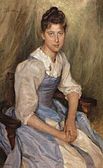Hanna Pauli

Hanna Hirsch, later Hanna Pauli[1] (Stockholm 13 January 1864 – Solna 29 December 1940) was a Swedish painter.
Life
Hanna Hirsch was a daughter of music publisher Abraham Hirsch. She was a friend of Eva Bonnier, and they followed each other through the painting school of August Malmström, and the Royal Swedish Academy of Arts in Stockholm. Hanna Hirsch studied in Paris from 1885 until 1887 and shared studio with Bonnier for part of that time. She had her portrait of the Finnish sculptor Venny Soldan (now in the Gothenburg Art Museum) accepted to the Paris Salon in 1887. The portrait is realistic and unconventional for its time in portraying a female artist at work (sitting on the floor with clay in her hands) rather than in proper bourgeois attire.

As was the case with most other Swedish artists of her generation, her painting stood closer to the French juste milieu painters than to the most impressionists; nevertheless, the thickly applied paint she used to show specks of light on the white table cloth on her 1887 painting Frukostdags (Breakfast time) (in Nationalmuseum, Stockholm) provoked one critic to comment that she had probably used the cloth to clean her brushes.
In 1887 she married the painter Georg Pauli and travelled with him to Italy for a year.
Her lifetime production was sparse and mostly consisting of portraits, such as the one of painter Karl Nordström (1890; in the Bonnier portrait collection, Nedre Manilla, Stockholm), writer Verner von Heidenstam as Hans Alienus (one of his literary characters, 1896), writer Selma Lagerlöf (1932, Nationalmuseum) and the group portrait Vänner ("Friends", 1907, Nationalmuseum) showing writer Ellen Key reading to a group in the home of the Pauli family.
Gallery
-
Portrait of artist Venny Soldan, (ca 1885).
-
Gerda
-
Verner von Heidenstam
Notes
- ^ She formally changed her name at marriage but signed paintings under her maiden name even after that. In her book on Eva Bonnier and Hanna Hirsch/Pauli (1999), Margareta Gynning uses the form Hirsch-Pauli throughout.
References
- Gynning, Margareta: "Pauli, Hanna", Svenskt biografiskt lexikon, 28, pp. 746-749
- Gynning, Margareta: Det ambivalenta perspektivet: Eva Bonnier och Hanna Hirsch-Pauli i 1880-talets konstliv, Stockholm: Bonnier, (Diss. Uppsala University), 1999.




